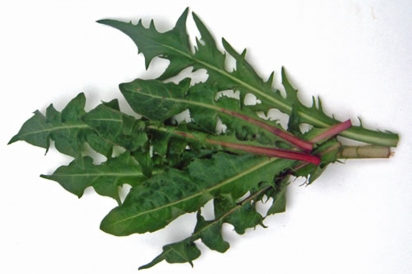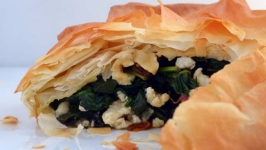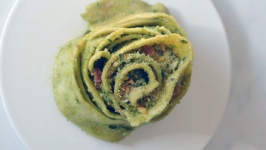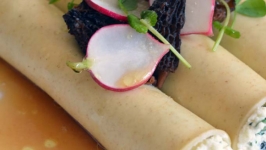Foraging Spring Vegetables
Waiting to harvest annual spring garden crops can feel like an eternity. There may be small amounts of deliciously sweet overwintered lettuce, spinach and kale to tide you over, but for reliable early harvests, you must count on perennial spring vegetables. There are several wonderful options. A bed of asparagus is a common first step; there are additional choices, but until you have waited out the requisite number of years for them to become established, you will have to forage for wild spring vegetables.
Wild Leeks
One of the first signs of spring is wild leeks pushing their way up through the forest floor. Ramps, as they are commonly known, have been enjoyed as a spring tonic in temperate climates for millennia. The City of Chicago takes its name from the Algonquian checagou, the word for the wild leeks that grew abundantly in the area. Germans, Scandinavians and the British all made generous use of rams as their spring tonic. Throughout the southern U.S. states ramp festivals remain a popular annual celebration. Whether known as ramps, wild leeks, wild garlic, ramson, wood leek, or ail des bois, they are well loved.
Wild leeks became so popular in Quebec, however, that over-picking led to a province-wide ban on their harvest. So when you find a patch in Ontario woods, please never harvest more than 15 percent of the largest bulbs. It takes about six years for them to regenerate. With mindful harvesting, they can remain a sustainable crop. The season commences very early but the tender green leaves soon die down (within two to four weeks) as the tree canopy fills in. Then mature leeks send up their flower stalks to eventually produce seeds. These often remain standing through the fall as markers for the patch.
If greedy harvesters are taking too many or you live too far from a patch, it is possible to cultivate wild leeks in a heavily shaded, humus-rich home garden that is kept continuously moist. (Under some tall hardwood trees or on the north side of a building is best.) Seeds are available from the woods or online. In late summer, sprinkle seeds on the ground and cover with several inches of decomposing hardwood-leaf litter. They should germinate the following spring. If they do not, wait for another year. Once germinated, it will take about six years to reach harvest size. Eventually these will start self-seeding to provide reliable springtime harvests. You can now understand why we need to safeguard our wild leek patches.
With their mellow garlicky leek flavour I anoint wild leeks as the Queen of Alliums. These tender gems wilt quickly, so wrap them in a damp newspaper and place in an open plastic bag. (They quickly rot without fresh air.) Trim off the bottom root button. Then make special use of every part—bulb, stem and leaves.
Simple preparations (raw or lightly cooked) properly emphasize this very special vegetable. Incorporate wild leeks in place of onions, leeks, garlic or scallions in your favourite soup, egg, rice, potato or pasta recipe. You can blend the leaves with oil and a little salt for a wonderful pesto. Or you could pour boiling white wine vinegar into a jar packed with bulbs and seal them for absolutely amazing pickles.
Fiddleheads
Ferns start their spring growth as tightly curled fronds that look like the scroll at the head of a fiddle. A wide variety are consumed around the world. Fiddleheads have been a traditional ingredient in the mountainous regions of India, Indonesia and Japan, as well as in the north of France and with First Nations people on this continent. The dominant edible variety in eastern North America is the ostrich fern. (You can confirm the fern's identity by the "U" groove along the inside of each stem.) It grows into 4-foot-high arching plumes from a clump close to the ground in moist, shaded riversides.
Carefully survey the sprouting clumps in your prospective area to determine if there has been recent flooding. This usually imbeds hard-to-remove sandy grit into the tightly wound fiddleheads. And polluted floodwater may have contaminated them, so move on to a cleaner higher area. To avoid harming the plants, cut off no more than half of the fronds from each crown. To be sure they are tender, the stems should be less than two inches long.
If you live too far from a riverside, unsustainable harvesting has spoilt your area, or your riverbank floods every year, consider growing ostrich ferns in your own garden. As with wild leeks, they need heavily shaded, humus-rich, continuously moist soil. Ferns do not produce seeds; they produce tiny spores. Being so difficult to work with, you should purchase small plants from a local nursery. Transplant these into your prepared site about three feet apart from each other. Lateral underground runners will start new plants to fill in the space. Wait at least two years before harvesting your first crop.
The easiest way to remove the papery husk that often clings to fiddleheads is to winnow them outside: Toss them from one basket to another in front of a fan until clean. Otherwise, agitate them in cold water to remove husks and any grit. Keep them fresh for several weeks by refrigerating in a plastic bag.
For a vegetable, they have unusually high amounts of omega-3 fatty acids and antioxidants. Fiddleheads taste like a delicious cross between asparagus, green bean, spinach, filbert and mushroom. They are at their best simply steamed until bright green and then dressed with a touch of butter, lemon juice, salt and pepper. Or enjoy their sophisticated flavour and dramatic presentation in your favourite omelette, quiche or pasta.
Dandelions
It is thought that this now ubiquitous plant evolved thirty million years ago. It has been used as a readily available nutritious food throughout history and across the world. It is only North Americans' anxiety over eating bitter foods that has impeded its acceptance here. True dandelion is much more aromatic than its lookalike Italian chicory cousin. Dandelion has yellow flowers, grows close to the ground, has aromatic leaves, and withers quickly. Chicory, on the other hand, has blue flowers, forms aerial branches, has a simple taste, and its large leaves remain turgid. What is sold in the produce section of stores as dandelion is usually a form of chicory, with toothy leaves that look like giant dandelion leaves.
To obtain true dandelion, you probably need to forage for them. With no shortage of plants, you can easily select the tallest, tenderest, most aromatic and non-bitter specimens. The trick is to avoid any that are flowering. Cut off the acrid leaves and flower stalk at ground level. The leaves that grow back will be fine as long as they are kept cool and moist. A partially shaded lawn provides these conditions, although harvesting the leaves free of grass can be a chore.
You can also consider growing them in your garden. Yes, cultivate dandelions. Selected seeds (usually from France, where they care about superior-flavoured leaves) are available in many seed catalogues. Choose packets from various sources to find your own favourite. These perennial greens are of course very easy to grow. Seed them in early summer to grow on for the rest of the year. They will be ready to harvest the following spring. Purchased dandelions typically flower later in the season and the leaves are more aromatic and less bitter. Since dandelion seeds are produced asexually (without pollen), the offspring are usually identical to the mother plant. So it is easy to select and produce your own superior variety of dandelion—one that grows tall, tender, aromatic, and with just the right amount of bitterness. For superior harvests throughout the summer, grow them under a 30 percent shade-cloth.
Each of us has differing sensitivities to bitterness. Part of this is cultural and part is physiological. Just try to accept that bitterness can actually be a delicious taste attribute. If necessary, you can tame dandelion's excessive bitterness by:
Diluting its bitterness by incorporating it with other leafy greens such as spinach or kale or adding it to cooked beans, grains or pasta.
Masking it with fat or oil, chilies or hot sauce, garlic or nuts.
Distracting from its bitterness with lemon juice, sweet fruit, or salty cheese.
If by any chance you cannot find enough suitable dandelions, you can substitute succulent wild chickweed, mustard, watercress, lambs quarters (goosefoot), pigweed (amaranth), or purslane.
Spring Forage Scrambled Eggs
By David Cohlmeyer
Makes 4 servings
This is a gentle way to introduce foraged vegetables to neophytes. If you find it too unusual for breakfast, it makes a great lunch or dinner offering.
- 1 cup cleaned fiddleheads, chopped wild leek greens or bulbs and/or chopped dandelion
- 8 eggs
- 1/4 cup cream or milk
- 1 tbsp unsalted butter
- Sea salt and freshly ground black pepper, to taste
Blanch the fiddleheads, wild leeks, and/or dandelion in 1/4-cup of simmering water until bright green, about 3 minutes. Drain well.
In a medium bowl, whisk the eggs and cream. In a skillet over low heat, melt the butter. Add the egg mixture. After they start to coagulate at the bottom of the pan, gently lift the eggs with a fork to allow liquid from above to flow to the bottom of the pan. Lift this again and lightly break the eggs into chunks. Stir in the cooked greens, salt and pepper. Warm through and remove from the heat. The eggs should still be creamy and glistening. Take care not to overcook them. Serve immediately with wholegrain toast.








